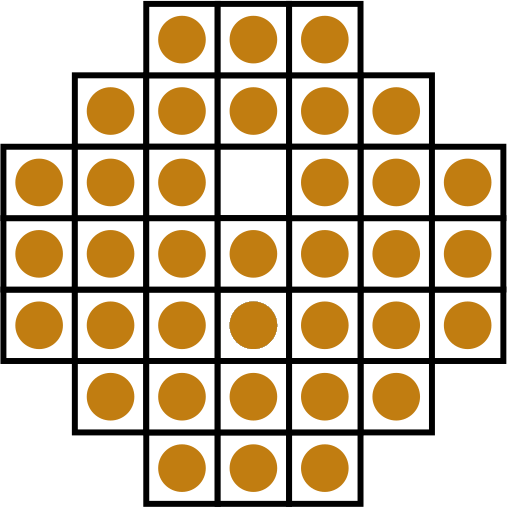

(Cristopher Moore, David Eppstein) - From the abstract: We solve the problem of one-dimensional peg solitaire. It is complemented by his more theoretical Analysis of Peg Solitaire page. (Jaap Scherphuis) - Jaap's page has a concise, memorable solution to the 32-peg "classic," or "central complement" puzzle, and some enumerative results. (John Beasley) I recommend Beasley's out-of-print book The Ins and Outs of Peg Solitaire, but if you can't find it, there is a generous amount of interesting reading on his web page, including more recent writings. (George Bell) A 2016 paper on computer search for particularly challenging solitaire problems, as well as symmetric ones. (George Bell) This article from Mathematics Magazine is a good place to start reading about the mathematical theory of the game. Simply jump the original peg over each successive peg as shown in the graphic until youve reached the destination peg-hole. You might want to start with one of the following articles instead. However, it is so comprehensive that it can be overwhelming.
#PEG SOLITAIRE SOLVER U SHAPE PLUS#
George Bell's collection of information about peg solitaire is the ne plus ultra, and his list of references is so extensive that this one is practically redundant. Peg Solitaire is rich in algebraic, combinatorial, and algorithmic theory. The difficulty ratings are subjective, so take them with a grain of salt. The collection aims to be interesting, and well-graded in difficulty, rather than comprehensive. Of the remaining problems, some I drew up by hand, and some were computer-generated. I modeled the graphics here on that version of the game. Perhaps you had the same one, the one with the professorial owl on the box top. They are using the beginnings of the same mental models that computer programmers use to create chess programs that can beat the best players in the world, or Amazon recommendations that, frankly, could be a bit more sophisticated.Some of the problems in this collection are drawn from the charming New Problems in Puzzle-Peg booklet (copyright 1929) included with the solitaire board I had as a child. Regardless of the specific algorithms your kids develop, the fact that they are developing algorithms is itself a mathematical experience. I have no idea what different methods and algorithms your kids might develop I only know the ones that I came up with as an adult. Over time, they might realize that this algorithm isn't quite sophisticated enough to win, and so they try to amend it to improve their score.

They create a goal and a rudimentary algorithm, such as "always jump towards the middle of the puzzle." So if there is a way to keep the pegs closer to each other, perhaps they can improve their score.

But as they play, your child may begin to notice patterns and change their decisions as a result.įor example, they might start to notice that at the end of the game, they usually have a few pegs stranded on the board, too far away to jump and remove each other. People who solve Rubik's Cubes in ten seconds use algorithms, but so to people who use long division to solve 524 ÷6. In either case, you are using a set of steps that can be generalized to solve all sorts of similar problems. Both versions of peg solitaire give kids a chance to develop, test, and improve algorithms for leaving one peg remaining.Īt first, kids will play the game more or less at random, hopping pegs wherever they see the opportunity. Simply put, an algorithm is a set of steps that one can use to solve a problem. Peg solitaire is a great way for kids to interact with algorithms.

That's it!Īs with many of my favorite mathematical games, the rules are simple to explain, but the game itself is a challenge for kids and adults alike. Your goal is to jump these pegs over each other, one by one, until only a single peg is remaining. You may remove pegs by jumping pver them with another peg, as in checkers.


 0 kommentar(er)
0 kommentar(er)
